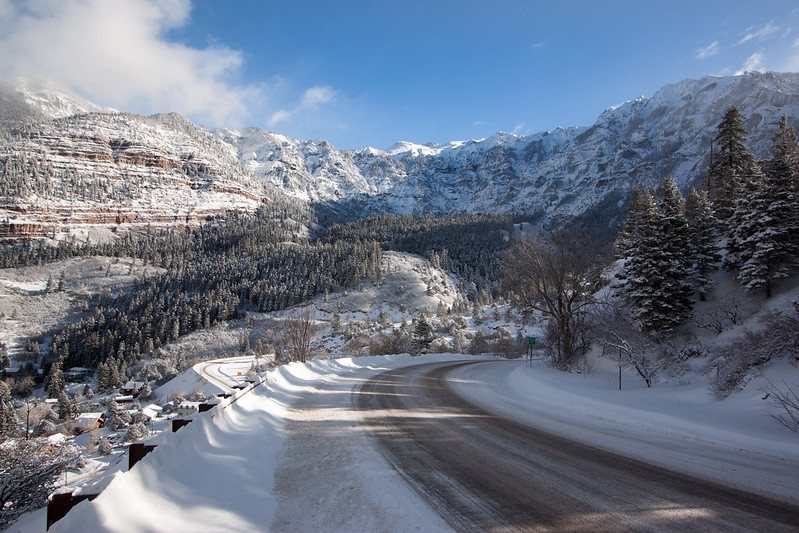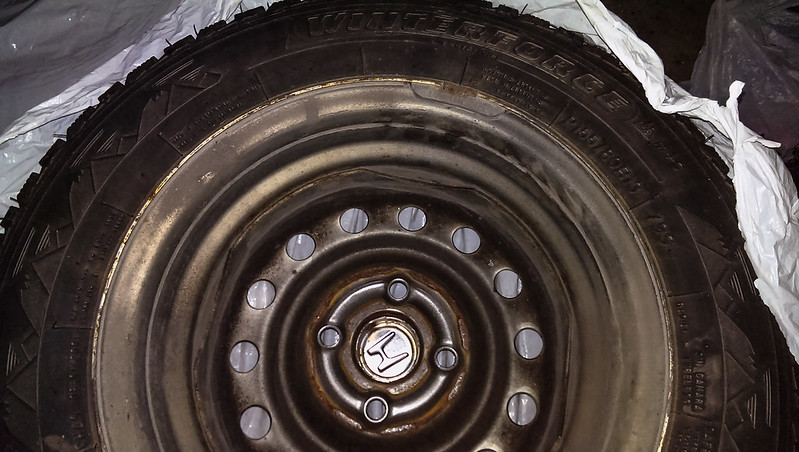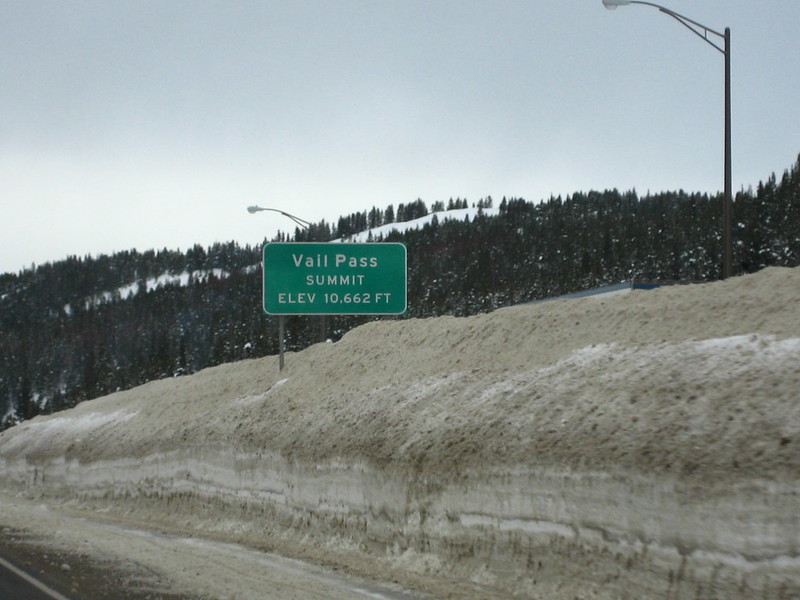victims for over 25 years.
Winter Driving in Colorado
Well, Thanksgiving traffic throughout the I-70 corridor was somewhat of a mess. I heard from friends who had to turn around at Empire on their way to Winter Park. Others had to take Loveland Pass to avoid Eisenhower Tunnel, thanks to snow and high winds.
And of course, there were a ton of us on the road. We are all traffic. For those new to winter driving in Colorado (and those who need a refresher), I thought I’d share some important tips for getting from Point A to Point B safely.
Why Is It so Hard to See Lines on the Road in Colorado DuringRain and Snow Storms?

Photo credit: Alan Stark / Flickr
Have you noticed that the lane lines in Colorado disappear during a hard rain, and they get easily buried by snow? Why don’t we have lane reflectors like in some other areas?
The answer is snow plows.
Because we need plows to scrape our roads, the lines on Colorado highways are purposely dug into the roadways so that the plows don’t scrape off the paint.
When it rains or snows, the moisture pools on top of the lines, making them harder to see. This is true even though the Colorado Department of Transportation uses reflective paint for our road lines.
How can you stay safe when you can’t see road lines? One tactic is to stay in the right lane, focus on the solid shoulder line (which is often easier to see), and stay as far to the right as possible. This will ensure that you’ve left a buffer for the left lane or oncoming traffic.
Do I Need Snow Tires in Colorado?

Photo credit: Roland Tanglao / Flickr
I know a lot of Coloradans who get by without snow tires, but they are also very aware of their tire health. These people would never head out into a storm with bald tires.
Better safe than sorry, I always say. I think it’s a good idea to get snow tires. The Colorado Department of Transportation shares these tips for winter-appropriate tires.
- Winter Tires: Winter tires are safest for snowy and icy conditions and are recommended for driving in winter weather. Tread patterns in winter tires provide extra traction and stability, while rubber compounds help the tire stay soft in cold temperatures for superior grip.
- All-Weather Tires: All-weather tires are considered safe in winter conditions, particularly conditions with heavy rain, slush or wet snow. Tread patterns in all-weather tires provide extra traction and stability, while rubber compounds allow the tire to stay flexible for various temperatures for grip on both wet and snowy roads and dry asphalt. Thus, all-weather tires are efficient year-round.
- Mud and Snow Tires (M+S): (M+S) tires are all-season tires that provide better starting, stopping and driving performance in snowy conditions than non-M+S tires. M+S tires are acceptable in light snow but are limited to the capabilities of winter tires.
All of these tires are Traction Law compliant as long as they have a minimum of 3/16″ tread depth.
What is Colorado’s Traction Law?

Photo credit: Rudi Riet / Flickr
Speaking of tires, if you visited CoTrip.org over the weekend like I did, you saw that several roads were under a Traction Law. What does that mean?
According to the Colorado State Patrol, the passenger vehicle traction law requires two-wheel drive passenger vehicles to have all-weather or mud-and-snow rated tires with adequate tread, or to affix chains or alternate traction devices.
Four- and all-wheel drive vehicles must have all drive wheels engaged and tires with adequate tread depth.
If a Traction Law is called, your all-season tires might not make the cut. It’s best to check before you hit the road.
Are you wondering how anyone would ever find out that you ignored the traction law? Picture all those news stories you’ve seen of car pileups at Eisenhower Tunnel or over Berthoud Pass.
When the cops show up, they will look to be sure everyone was in compliance. Those who weren’t will be fined. If you don’t have the proper equipment during a Traction Law, you could face fines as low as $130 or as high as $650.
Colorado Department of Transportation has an online interactive quiz to help you assess whether you are ready for the traction law. Take it here.
Additional Tips for Staying Safe on Colorado’s Winter Roads

Photo credit: Jeffrey Beal / Flickr
That’s a lot of information about tires and road lines, but there are obviously many things you can do behind the wheel to increase your safety on Colorado’s winter roads. Here are a few:
- Drive slowly. Crashes happen more often and are more severe with higher speeds.
- Drive defensively, not aggressively. Everyone on the road wants to get home safe. Be a polite, defensive driver.
- Wear your seat belt. You may be the best driver on the road, but that means you’re surrounded by people who are worse drivers than you. Wear your seat belt and stay safe.
- Use your low-beam headlights in bad weather. Your high beams will reflect off of the snowflakes, blinding you to the road ahead.
- Don’t use cruise control. You must be able to adjust your speed according to conditions, which change rapidly.
- Leave extra space between you and the vehicle ahead of you. If someone rear-ends you, and you then rear-end the person in front of you, you may be held at fault for the damage you caused. Stay back.
- Manage skids. If your car begins to skid, remove your foot from the accelerator or brake and steer in the direction of the skid. Once steady, turn the wheel straight and proceed.
It’s still early in the Colorado winter season, so it’s good to refresh yourself on these fundamentals now. And make sure to discuss them with any young drivers in your family! Finally, always remember: if you do get into a crash on I70 or anywhere else in Colorado, please call or text me for a free consultation. 303-388-5304
Free Consultation
Search For
Recent Articles
- SUV and Passenger Car Crash in Denver Leaves One Seriously Injured
- Traffic Incident Involving Pedestrian Reported in Sloan Lake
- Bicycle and SUV Incident Reported at W 29th Ave and N Federal Blvd
- Pedestrian Accident Reported at E Colfax Ave and N Colorado Blvd
- Possible DUI Investigated in Two-Car Collision at Lafayette and 1st Ave
Categories
- Arvada
- Aurora
- Auto Accident eBook
- Auto Insurance
- Bicycle
- Bicycle/Motorcycle Accidents
- Bodily injury
- Car accidents
- Centennial
- Colorado
- Colorado Legislature
- community
- Concussion
- Denver
- Denver Metro Motor Vehicle Accidents
- distracted driving
- DUI Accidents
- Englewood
- Events
- Flood Insurance
- Fort Collins
- Highlands Ranch
- Hit and Run
- In The News
- insurance companies
- Lakewood
- Littleton
- Marijuana DUI
- Motorcycle Accidents
- Motorcycle Insurance
- Motorcycle Law eBook
- Motorcycles
- Newsletter
- Pedestrian
- Personal Injury Law
- Safe Driving
- Safety
- Scooters
- technology
- Thornton
- Tips
- Uncategorized
- vibrio vulnificus bacteria
- Videos
- Westminster
- Winter Driving
Archive
- December 2024
- November 2024
- October 2024
- September 2024
- August 2024
- July 2024
- May 2024
- April 2024
- March 2024
- February 2024
- January 2024
- December 2023
- November 2023
- October 2023
- September 2023
- August 2023
- July 2023
- June 2023
- May 2023
- April 2023
- March 2023
- February 2023
- January 2023
- November 2022
- September 2022
- April 2022
- March 2022
- February 2022
- January 2022
- December 2021
- November 2021
- October 2021
- September 2021
- August 2021
- July 2021
- June 2021
- May 2021
- April 2021
- January 2021
- December 2020
- November 2020
- October 2020
- September 2020
- August 2020
- July 2020
- June 2020
- May 2020
- April 2020
- March 2020
- February 2020
- January 2020
- December 2019
- November 2019
- October 2019
- September 2019
- August 2019
- July 2019
- June 2019
- May 2019
- March 2019
- February 2019
- January 2019
- December 2018
- November 2018
- October 2018
- September 2018
- August 2018
- July 2018
- June 2018
- May 2018
- April 2018
- March 2018
- February 2018
- January 2018
- December 2017
- November 2017
- October 2017
- September 2017
- August 2017
- July 2017
- June 2017
- May 2017
- April 2017
- March 2017
- February 2017
- January 2017
- December 2016
- November 2016
- October 2016
- September 2016
- August 2016
- July 2016
- June 2016
- May 2016
- April 2016
- March 2016
- February 2016
- January 2016
- December 2015
- November 2015
- October 2015
- September 2015
- August 2015
- July 2015
- June 2015
- May 2015
- April 2015
- February 2015
- December 2014
- November 2014
- October 2014
- September 2014
- July 2014
- June 2014
- May 2014
- April 2014
- March 2014
- February 2014
- January 2014
- October 2012
- September 2012
- August 2012
- July 2012
- February 2012
- March 2011
- October 2010